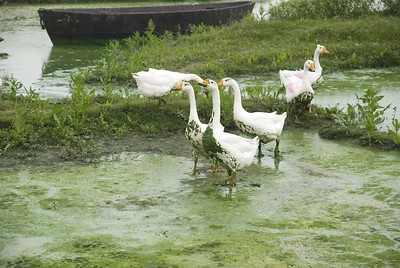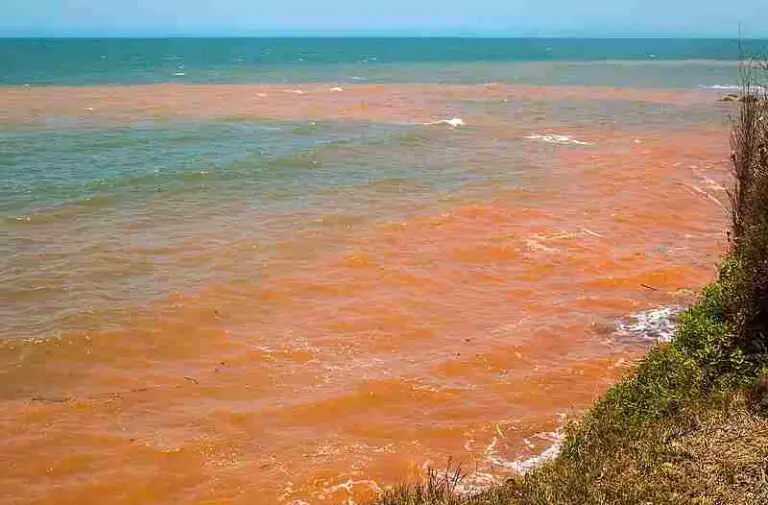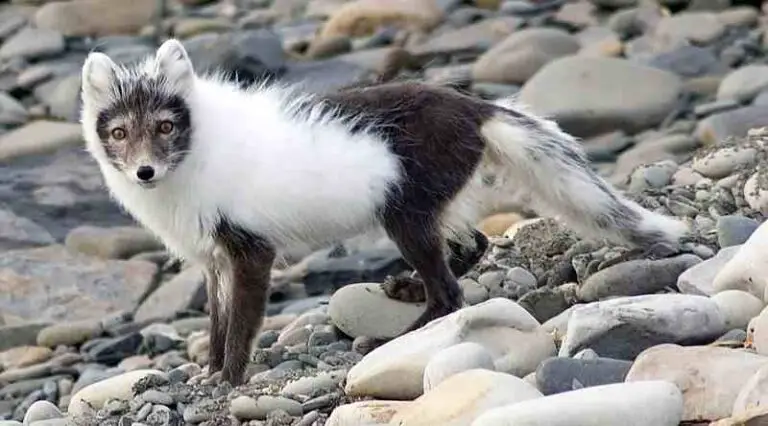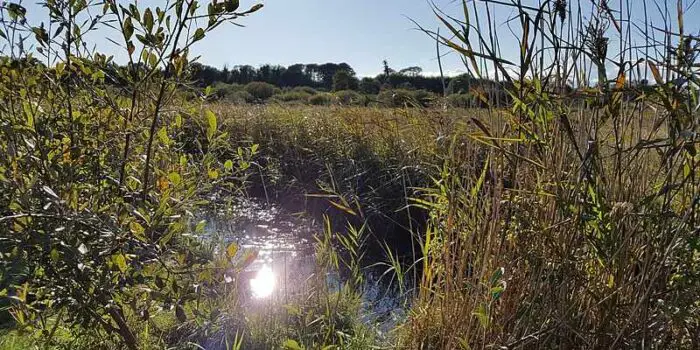5 Agricultural Pollutants and Their Characteristics Discussed
Agricultural pollutants include; nutrients, heavy metals, persistent organic pollutants (POPs), sediments and pathogens.
They can be generally described as; materials that can cause agricultural pollution when introduced into a medium or environmental system.
This article discusses agricultural pollutants and their characteristics, as follows;
1). Nutrients (as one of the Classes of Agricultural Pollutants)
Nutrients can act as agricultural pollutants, when they are present in excessive amount (that is; high concentration) in a given medium.
In spite of the fact that they are essential for the growth of organisms and continuity of both biotic and abiotic elements of ecosystems; unhealthy levels of these nutrients can have detrimental environmental impacts, and could pose a threat to species richness and biodiversity.
Excessive nutrient amounts can come from unsustainable agricultural activities; namely the unregulated application of chemical fertilizer (and in some cases; manure) to soil [5].
It commonly affects aquatic ecosystems, because the ambient fluid medium in marine water bodies, lakes and ponds, is an ideal distribution medium for both soluble and insoluble foreign materials.
The outcome of excessive nutrient influx in water bodies is called eutrophication, and can be observed in the form of unnaturally-rapid algal growth, that alters the oxygen and carbon cycles, reducing the amount of dissolved oxygen (DO) available, and threatening the survival of aquatic organisms [1].
Major pollutants from agricultural soils that cause eutrophication are; nitrogen (N) and phosphorus (P).
Most fertilizers are chemically-dominated by nitrogen in their composition (these are called 'nitrogen-based fertilizers'), and their excessive application goes along with the risk of leaching and transport of nitrogen compounds into adjacent water bodies, including groundwater reserves that are relied upon for domestic purposes.
Fertilizers also contain phosphates, which can be leached and transported like nitrogen compounds, into water bodies where they have hazardous effects.
Excessive nutrients can also be taken-up by crops, which become contaminated and unsafe for consumption, as a result. Nutrient pollution affects nutrition through its degrading effects on crops and soil.

2. Heavy metals
Heavy metals are a group of metallic elements with relatively high molecular density, that can be toxic to biotic systems.
In agriculture, there are several possible sources of heavy metals, including; applied chemicals, agro-industrial processes and materials, energy resources for electricity-supply to equipment, and wastewater.
Examples of heavy metals that are agricultural pollutants include; cadmium (Cd), mercury (Hg), lead (Pb), nickel (N), chromium (Cr), and arsenic (As) [4].
Heavy metals are potent agricultural pollutants because of their persistent and toxic attributes, which enable them accumulate in both biotic and abiotic systems.
Agricultural soils that contain significant amount of heavy metals are not healthy to support crops or produce forage for livestock. These soils are susceptible to economic, social and environmental issues, like; low crop yield, contamination of crops, soil deterioration, water pollution, and poisoning of consumers.
Plant biological processes like photosynthesis can be altered by heavy metal uptake [7], causing plant growth to become stunted, and thereby disruption the trend of regional food chains.
Crops growing on heavy metal-polluted soil are affected by the degradation as well, because they tend to take-up heavy metals from the soil through their vascular tissues, and roots.
These heavy metals accumulate in the edible tissues and parts of the plant like its leaves, grains and fruits; in a process called bio-accumulation [2]. Plants exposed to such conditions become toxic to both animals and humans that consume them.
Heavy metals are a prominent cause of water pollution in both urban and rural areas, because of their high mobility and the ease with which they are trans-located into surface and groundwater bodies.
Lastly, heavy metals alter the physicochemical state of soils, such that they lose their fertility and the size of microbial populations that recycle nutrients through their metabolic processes, like biodegradation.
The same principle of uptake that causes crops to be contaminated by heavy metals from the soil, can be used in the remediation of polluted soils. This approach is a bioremediation technique called phytoremediation, and can be viewed as a potential solution to agricultural pollution by heavy metals.
3. Persistent Organic Pollutants (POPs) (as one of the Classes of Agricultural Pollutants)
Persistent organic pollutants (POPs), are a group of organic compounds that derive their name by having toxic and ecologically resilient attributes.
These compounds are 'persistent', meaning they have high-resistance to changes in their environment, and this makes them capable of remaining present and potent in a medium, for extended periods of time.
Like heavy metals, persistent organic pollutants can accumulate in the tissues of living organisms. They are also highly-mobile and may be trans-located and dispersed with relative ease.
Persistent organic pollutants are fairly versatile in their effect, and can be linked to incidents of water, land and air pollutions respectively.
The 12 initial persistent organic pollutants identified in the 2001 Stockholm Convention on Persistent Organic Pollutants, are listed in their given order as follows;
1. Aldrin
2. Chlordane
3. Dichlorodiphenyltrichloroethane (DDT)
4. Dieldrin
5. Endrin
6. Heptachlor
7. Hexachlorobenzene
8. Mirex
9. Toxaphene
10. Polychlorinated biphenyls (PCBs)
11. Polychlorinated dibenzo-p-dioxins (PCDDs)
12. Polychlorinated dibenzofurans (PCDFs)
The above-listed POPs are also referred to as the 'dirty dozen', and several more persistent organic pollutants have been identified in subsequent years, bringing their number to above 20 toxic compounds [3].
Pesticides are the most common source of persistent organic pollutants in agricultural systems.
They could be introduced by atmospheric drift (wind-translocation) or direct application, and can remain potent and un-removed for long periods.
POPs can be leached into groundwater reserves, and may accumulate in organic biomass of plants and animals, where they pose health risks.
The adoption of sustainable agricultural practices, organic farming and biological control to address farm pests; as well as remediation and waste management, are all recommendable ways to address agricultural pollution by persistent organic compounds.

4. Sediments
Although they are not inherently toxic, sediments can act as pollutants when introduced into a medium or environmental system, in excessive and unsustainable amounts.
These sediments are known to have negative effects on water and air quality (although more-commonly on water).
Agricultural lands can be sources of sedimentary pollutants like soil particles and organic materials.
Influx of sediments into water bodied close to agricultural lands is possible provided sustainable methods of soil conservation (and water conservation) are not implemented on the concerned lands.
Over-tillage, overgrazing, and unsustainable approach to irrigation can all cause sediments to become susceptible to displacement and relocation to adjacent environments.
Sediments can serve as vectors to agricultural chemicals like pesticides and fertilizers, which they may carry along with them info water bodies when erosion and displacement occur. These chemicals can pollute their new environment, and may have negative ecological effects like eutrophication.
The sediments can fill small pools and crevices that serve as micro-habitat for some organisms. This can in turn affect biodiversity.
Sedimentary particles that are small-sized and which occur in suspension in water, can reduce solar penetration and clarity, which will cause a decline in photosynthesis rates, and the availability of bioenergy and food to aquatic organisms.
Aside natural aquatic ecosystems, sedimentary pollutants from agricultural lands can also infiltrate manmade water systems like hydroenergy reservoirs (usually paired with water dams), and rainwater-harvesting pools for water storage.
In such systems, the sediments could reduce efficiency and storage capacity, among other potential, negative effects.
Mitigating agricultural pollution by sediments and soil particles is possible through practices that ensure the sustainability of healthy soil conditions. Examples of such practices are; conservation tillage, cover cropping, contour cultivation, sustainable irrigation and terrace farming.
5. Pathogens (as one of the Classes of Agricultural Pollutants)
Pathogens are a group of microorganisms that act as disease vectors, causing illnesses in plants, animals and humans with which they come in contact.
They are microbial agro-pollutants because these pathogens can grow and multiple in agricultural waste or effluents, like unclean irrigation water and livestock manure.
When agriculture is not practiced in a manner that limits their growth and spread, pathogens can be transmitted into biotic and abiotic systems from agro-wastes.
Examples of pathogenic agricultural pollutants are; viruses like Hepatitis B., bacteria like Salmonella spp., and protozoan parasites like Crypotosporidium [6].
Mitigating agricultural pollution by pathogens can be achieved through careful effort to treat waste and ensure hygiene of farm materials, equipment and activities.
Conclusion
The classes of agricultural pollutants are;
1. Nutrients
2. Heavy metals
3. Persistent Organic Pollutants (POPs)
4. Sediments
5. Pathogens
Below is a table summarizing agricultural pollutants in terms of their major classes, sources, examples and potential impacts;
Agricultural Pollutant | Source(s) | Examples | Potential Impacts |
Heavy metals | Livestock slurry, pesticides, herbicides | Mercury (Hg), cadmium (Cd), arsenic (As) | Soil and water contamination, fertility loss, poisoning of plants and animals, human health risk |
Persistent Organic Compounds | Pesticides | chlordane, aldrin, DDT, endrin, mirex, hexachlorobenzene, heptachlor, toxapheme | food chain disruption, death of non-target organisms, biodiversity loss, public health risk |
Nutrients | Fertilizer | phosphorus (P), nitrogen (N) | Eutrophication, oxygen depletion, biodiversity loss, groundwater degradation |
Sediments | Over-tilled/overgrazed agricultural land | Mud, sand, silt | Water clogging/clouding, oxygen depletion, contamination |
Pathogens | Livestock slurry, Compost | Escherichia Coli, Cryptosporidium | Waterborne illnesses |
References
1). Ansari, A. A.; Gill, S. S.; Khan, F. A. (2010). "Eutrophication: Threat to Aquatic Ecosystems." Eutrophication: causes, consequences and control (pp.143-170). Available at: https://doi.org/10.1007/978-90-481-9625-8_7. (Accessed 26 May 2023).
2). Khan, A.; Khan, S.; Khan, M. A.; Qamar, Z.; Wagas, M. (2015). "The uptake and bioaccumulation of heavy metals by food plants, their effects on plants nutrients, and associated health risk: a review." Environ Sci Pollut Res Int. 2015 Sep;22(18):13772-99. Available at: https://doi.org/10.1007/s11356-015-4881-0. (Accessed 26 May 2023).
3). Palanisami, T.; Naidu, R. (2010). "The Dirty Dozen Become the Dirty 21:the new list of stockholm priority contaminants(POPs)." Available at: https://www.researchgate.net/publication/259457855_The_Dirty_Dozen_Become_the_Dirty_21the_new_list_of_stockholm_priority_contaminantsPOPs. (Accessed 26 May 2023).
4). Rashid, A.; Schutte, B. J.; Ulery, A.; Deyholos, M. K.; Sanogo, S.; Lehnhoff, E. A.; Beck, L. (2023). "Heavy Metal Contamination in Agricultural Soil: Environmental Pollutants Affecting Crop Health." Preprints.org. Available at: https://doi.org/10.20944/preprints202305.0398.v1. (Accessed 26 May 2023).
5). Sabri, K. H. (2015). "Synthetic Fertilizers; Role and Hazards." Available at: https://doi.org/10.13140/RG.2.1.2395.3366. (Accessed 26 May 2023).
6). Steele, M.; Odumeru, J. (2004). "Irrigation water as source of foodborne pathogens on fruit and vegetables." J Food Prot. 2004 Dec;67(12):2839-49. Available at: https://doi.org/10.4315/0362-028x-67.12.2839. (Accessed 26 May 2023).
7). Yang, Y.; Zhang, L., Huang, X.; Zhou, Y.; Quan, Q.; Li, Y.; Zhu, X. (2020). "Response of photosynthesis to different concentrations of heavy metals in Davidia involucrata." PLoS One. 2020 Mar 16;15(3):e0228563. Available at: https://doi.org/10.1371/journal.pone.0228563. (Accessed 26 May 2023).






